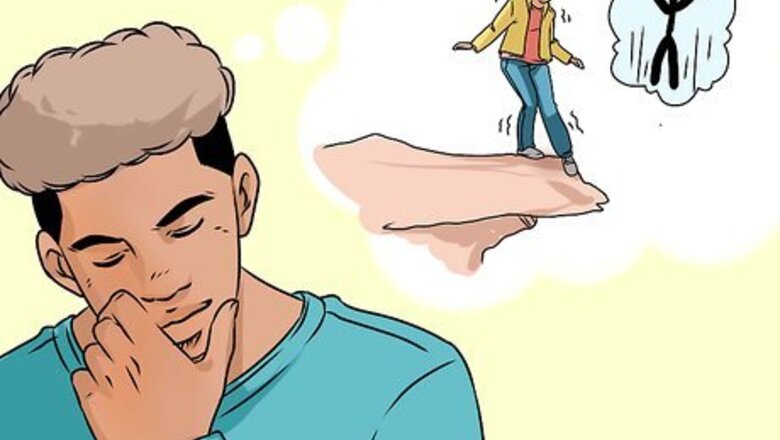
views
X
Trustworthy Source
PubMed Central
Journal archive from the U.S. National Institutes of Health
Go to source
While nearly everyone experiences some degree of anxiety at the thought of a great, perilous drop, the fear is debilitating for some. If your fear of heights is so extreme that it interferes with your performance at school or work or hampers your enjoyment of everyday activities, you might have acrophobia. Learn about acrophobia and effective methods to deal with your fear.
Understanding and Potentially Facing Your Fear
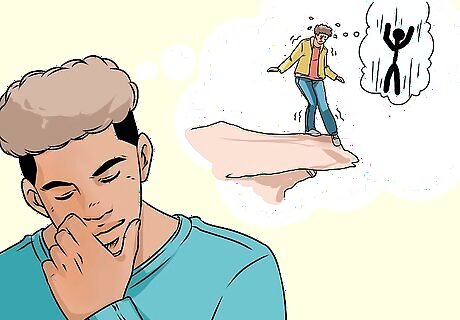
Determine the exact triggers for and intensity of your fear. You might need specialized treatment for a phobia rather than just being treated for another type of anxiety disorder, since you may have feelings of extreme stress from just thinking about being at a certain height. You may also experience physiological changes, such as heightened heart rate and blood pressure and increased sweating. If so, you may need specialized treatment for a phobia rather than just being treated for another type of anxiety disorder. If your fear of heights isn’t quite as severe as this, you may be able to work towards easing any discomfort you feel at certain heights with a little practice. On the other hand, if your discomfort is so severe that you can't face it yourself, you may need to move on to trying therapy or treating it with medication. For example, have you ever not taken a job because it was located above a certain floor, or passed up the opportunity to meet with important people because they asked you to meet at a location too high off the ground? If so, it could indicate something more serious than a mere “fear of heights,” like a phobia/anxiety disorder. If you aren’t sure how many times your fear of heights has kept you from doing what you want, sit down and make a list. Think back to all the times you didn’t do what you wanted or needed to do because of your fear. Putting them down on paper could give you a better sense of how seriously your fear has impacted your life.

Consider the likelihood of any actual harm resulting from the situations you fear. By definition, a phobia is an “irrational” fear of experiences that most people would not find threatening. But, if your fear of heights is relatively minor, an appeal to statistics could put things in perspective. For the most part, the sorts of things that trigger a fear of heights (skyscrapers, airplanes, and roller coasters, for instance) are incredibly safe. These things are specifically engineered to be as sturdy and secure as possible. It's easy to forget just how unlikely it is for you to suffer any harm at all from normal, everyday activities like flying or working in a tall building. For instance, depending on the airline, the odds of being involved in a fatal plane crash can be as low as about 1 in 20 million.. Compare that to the odds of any given US citizen being struck by lightning, which are estimated to be about 1 in 1 million..
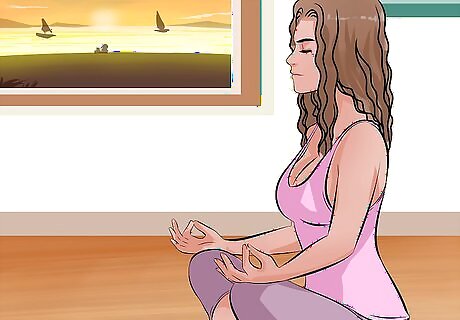
Relax. Relaxation activities that focus on embodiment, like yoga or meditation, can help you influence how your fear or anxiety affects your life. This can be something as simple as practicing deep breathing exercises while thinking about the situations you fear. Or it can include time spent attending a yoga class. These practices can help you become sensitive to how your emotions are connected with physiological processes, like breathing, heart rate, and sweating. Getting regular exercise, plenty of sleep, and maintaining a healthy diet are all great ways to regulate physiological processes related to phobias and anxiety. Starting small, like going on walks regularly or drinking more homemade fruit smoothies instead of eating fatty snacks, can get you on the right path.

Consider removing caffeine from your diet. Caffeine consumption may be a contributing factor to anxiety related to acrophobia. Limiting or abstaining from caffeine could help alleviate symptoms. In addition, cutting down on caffeine is likely to make you less high-strung and more relaxed, which can make it easier to confront your fear.
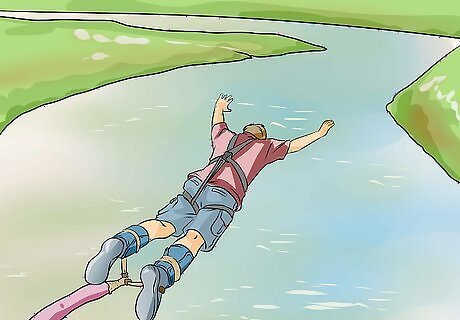
Gradually expose yourself to your fear. Try to slowly and progressively expose yourself to greater heights. For instance, you might want to start by simply studying on a 2nd-story balcony. Next, you could try to hike a large hill and look down over the distance you covered. When you're comfortable, continue exposing yourself to greater heights. If you can, always try to feel as supported as possible during these activities, by inviting a friend along, for example. Take pride in each accomplishment and don't lose momentum. With patience, you might eventually find yourself bungee jumping to celebrate your new strength. It can be very difficult to force yourself to do something you know will make you nervous. To give yourself a little extra "push", create situations where you'll have to confront your fear. For instance, if you're at a carnival and a friend wants you to go on a certain scary ride, tell him you'll do it and buy yourself a ticket. You're more likely to do it if you're already invested in the experience. Don't forget that you can use relaxation techniques to calm your jitters.
Trying Therapy
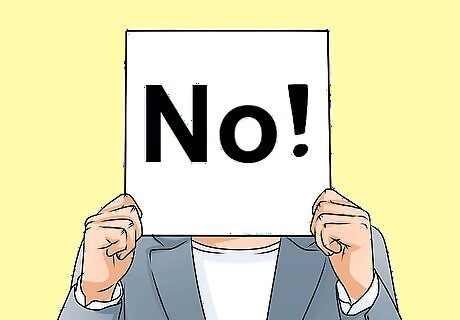
Know your personal limits. If you find yourself consistently missing out on opportunities because of your fear of heights and have already tried facing your fear, you might want to consider more long-term options. Explore these options in depth realizing they may help you seize opportunities. Studies have shown that various forms of treatment you might encounter in therapy, such as Cognitive-Behavioral Therapy (CBT), are helpful in managing specific phobias like acrophobia.
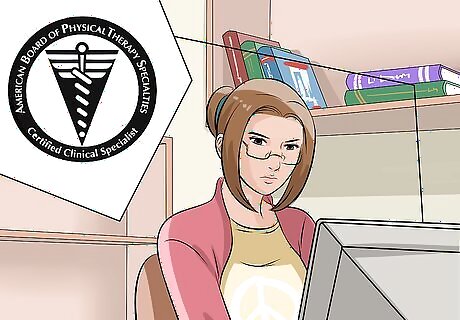
Find a therapist that suits your needs. There are numerous schools of psychotherapy, ranging from the traditional psychoanalytic method to existential and alternative approaches. The goal of any therapy program should be to help you safely and gradually lessen your fear while teaching you how to control your anxiety. Therapy may or may not be coupled with medicinal treatments. Ultimately, you must decide which type of therapy is the best option for you. But, there are things you should consider when choosing a therapist, including: Accreditation. Before beginning a therapy program, look into the education and certification of those therapists and counselors you are considering. Try to find a therapist or counselor who is licensed in his or her field, and with some type of expertise in phobia/anxiety treatment. Experience. Try to find a therapist who has been in practice long enough to generate a number of happy, healthy former patients. If you can, talk to some. Ask them how effective and comfortable their experience was and whether they would recommend their therapist. Think twice about therapists who seem inexperienced or are unable to back up claims of success. Method of treatment. Most reputable therapists use modern, scientific techniques that have been subjected to peer review in legitimate medical publications. But, holistic and alternative methods have been researched and are widely effective for some people.
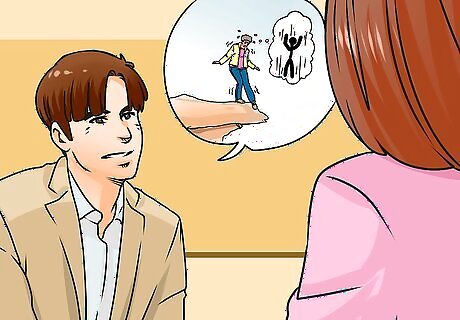
Meet with your therapist and discuss your acrophobia. Once you think you've found a suitable therapist, schedule a meeting and see if the therapist is a good fit. Different therapists may take different approaches to tackling your fear. But, nearly all will first ask you to describe your fear, asking questions about how long you've had it, any problems it's caused you, etc. Be completely honest with your therapist. The more information you can supply, the easier it will be to treat you. Also, be sure to communicate with your therapist as to what techniques do and do not seem to be working.

Learn anxiety control techniques. You'll probably learn how to confront and control your anxiety. This doesn't try to remove your anxiety, but to make it more manageable. With a therapist, you'll learn to cope differently and begin to master your thoughts and feelings. Eventually, you'll learn to be more at peace with what you can and what you must learn to accept.
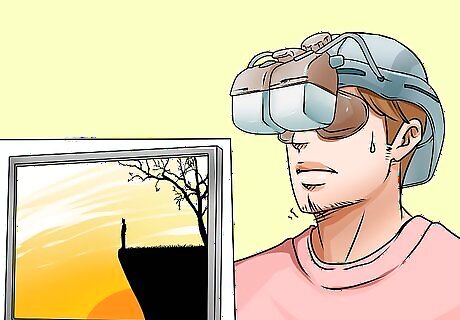
Experience gradual exposure therapy. One way that some (but not all) therapists approach phobias is to desensitize patients by gradually increasing their exposure to the stimuli that cause the fear, starting with relatively small experiences and slowly increasing sensation so that the patient develops a tolerance. For example, you might simply imagine standing at the edge of a cliff. Then, when this becomes manageable, you might look at a picture taken from a high vantage point. In recent years, virtual reality has offered therapists many exciting possibilities for safely letting patients overcome a fear of heights gradually in a controlled environment. Eventually, when the patient has made significant process, the patient may take a plane flight or some other act that initially would have caused great fear.

Be prepared to do your homework. Many therapists will assign take-home readings and exercises to reinforce mental and physical techniques you have been taught. You will be asked to challenge your own negative thought patterns and work on coping strategies on a day-to-day basis. Homework may include activities like breathing exercises, thought experiments, and more.
Treating Acrophobia with Medication

Find a psychiatrist or doctor familiar with prescribing medication for phobic disorders. It's important to choose a doctor whose expertise is suited to your problem. If you don't know any doctors or psychiatrists who prescribe medication for phobias, a good way to start looking is by contacting your family practitioner doctor. She will probably be able to refer you to a trusted colleague. Realize that medication-based options will not solve the underlying psychological issue that causes acrophobia. But, it can make life much easier by easing your anxiety and allowing you to relax. Consider using alternative and natural medications/treatments. They could include acupuncture, meditation, or essential oils. Be sure to talk to your doctor before trying of these methods.

Speak openly with your doctor. Communication is key if you are seeking medication for your acrophobia. Describing your symptoms as clearly and thoroughly as possible will help your doctor make a decision regarding possible treatment options. Share your symptoms openly with your doctor and let your doctor help you.

Research available drugs as much as possible. Not every doctor will be familiar with all of drugs that are available for treatment of acrophobia, so you may want to do your own research on these drugs. Share any concern you may have with your doctor and let your doctor provide useful feedback. Many drugs are reported to have negative side-effects. It's alright if you decide that these outweigh the benefits for you. Here are a few of the most common types of medication that your doctor might prescribe you: Antidepressants such as SSRIs or SNRIs are drugs that typically act upon and increase the levels of certain neurotransmitters responsible for regulating mood. Benzodiazepines are fast-acting, psychoactive drugs that can be useful for short-term relief of anxiety. While effective in the short-term, benzodiazepines can be habit forming. Beta blockers work by blocking adrenaline. This medication is mainly useful for the relief of the physical symptoms of anxiety, such as trembling or rapid heartbeat.

Seek treatment for visual/vestibular system ailments. Though the cause of acrophobia isn't entirely understood, research has suggested it may be related to the way the body interprets visual and spatial stimuli from the vestibular system and eyes. For some sufferers, acrophobia may come from an inability to perceive visual and spatial cues at great heights, where the importance of such information is heightened. This may lead sufferers to feel disoriented or dizzy and incorrectly judge the positions of their own appendages. In this case, acrophobia may have a physiological cause, rather than a psychological one, so talk to your doctor. You may be referred to a medical specialist who can give you insight into physical causes of your fear.

Consider all of your options. In some cases, especially if traditional treatments aren't working, you might want to look into approaches that have been labeled “alternative,” “complementary” or “integrative.” These approaches are not for everyone, but they have been shown to be effective under certain conditions. These can include forms of treatment as diverse as acupuncture, mind-body centering exercises that increase the relaxation response, guided imagery to engage the mind in the healing process, and/or eye movement desensitization and reprocessing biofeedback. As with most practices, it’s always a good idea to consult a trusted physician before beginning any form of intensive practice.
Avoiding Damaging Myths
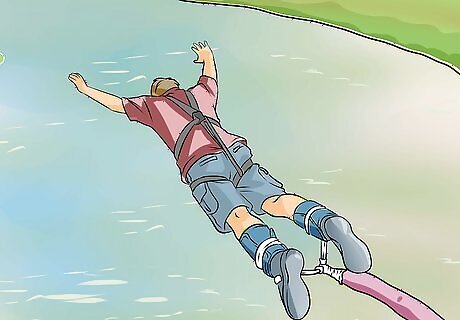
Don't "jump in to the deep end." People are often told to face their fears by doing something that would normally terrify them. For someone suffering from a fear of heights, this could mean something like riding a roller coaster, going skydiving, or looking over the edge of a cliff. Recent research has shown that acrophobia is an innate, rather than a learned condition, which means that pushing acrophobics "in to the deep end" may have no effect at all. It may even aggravate the fear. Further research is needed to find a definitive cause for acrophobia. Until the fear is fully understood, it is not a good idea to expose acrophobics to extreme heights without first treating the fear with therapy, medication, etc.

Don't simply tolerate your acrophobia. If a fear of heights keeps you from working, relaxing, or doing the things you love, it's a genuine condition and not something that you should try to tolerate. "Getting tough" or "just dealing with it" aren't good strategies for living with a real phobia. You can actually create extreme stress and make poor decisions if you try to hide your fear of heights with a tough exterior. You are stronger than you realize. Show strength by seeking real treatment. Meet with a doctor, psychiatrist, or experienced therapist to begin overcoming your fear.




















Comments
0 comment